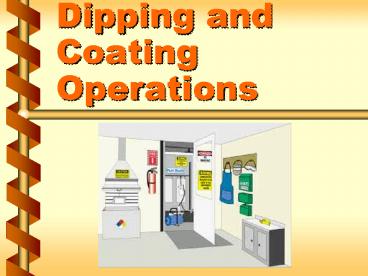Dipping and Coating Operations - PowerPoint PPT Presentation
1 / 14
Title:
Dipping and Coating Operations
Description:
Dripping. Spattering. 2a. Hazards of operation. Wet floors. Mats. Grating. Slip-resistant ... For air contaminant levels above desired levels or for oxygen ... – PowerPoint PPT presentation
Number of Views:67
Avg rating:3.0/5.0
Title: Dipping and Coating Operations
1
Dipping and Coating Operations
2
Processes that use dip tanks
- Paint dipping
- Electroplating
- Pickling
- Quenching
1a
3
Processes that use dip tanks
- Tanning
- Degreasing
- Stripping
- Cleaning
1b
4
Processes that use dip tanks
- Roll coating
- Flow coating
- Curtain coating
1c
5
Hazards of operation
- Open-surface tanks
- Splashing
- Dripping
- Spattering
2a
6
Hazards of operation
- Wet floors
- Mats
- Grating
- Slip-resistant footwear
2b
7
Hazards of operation
- Equipment failures
- Ventilation systems
- Toxic vapors
- Respirators
2c
8
Hazards of substances in open-tank processes
- Hazard communication is essential
- Material safety data sheets (MSDSs)
- By-products created by process itself
3a
9
Personal protective equipment
- Foot protection
- Gloves
- Aprons, coats, jackets, sleeves
4a
10
Personal protective equipment
- Garments impervious to liquids
- Chemical goggles
- Limitations of PPE
4b
11
Emergency procedures
- For air contaminant levels above desired levels
or for oxygen levels below 19.5 percent - Wear respirators to reduce exposure
- Respirator storage
- Respiratory standard 29 CFR 1910.134
5a
12
Emergencies involving tank entry
- Use respirators such as
- Self-contained breathing apparatus
- Supplied-air (mask with hose and blower)
- Air-purifying respirator
- Use PPE to protect against absorption of
hazardous substances
6a
13
Emergencies involving tank entry
- Stand-by personnel outside tank
- Trained
- Has suitable respirator
- Able to communicate with employee in tank
- Rescue lifelines
6b
14
Summary of main points
- Hazards of operation
- Hazards of substances used
- Personal protective equipment
- Emergency procedures
7a































